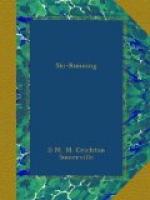Having put your skins on, lay the Skis flat on the snow so that the skins will freeze on.
Sealskins must never be dried by a heater or stove as the heat shrivels them and they are ruined.
When not in use, they can be kept rolled up in a bag and should be carried in the Rucksack rather than hanging on outside. Frozen skins are very difficult to attach.
A scraper should invariably be carried when Ski-ing, even on the Nursery slopes. These are made of aluminium and the best type has a groove which will fit into the groove of the Ski and scrape this as well as the flat surface, as ice is apt to adhere there also. Some runners carry, attached to their belt, a Norwegian hunting knife in its case. This is excellent for scraping the Skis and for any purpose for which a strong knife may be wanted, but it always seems to me that it would be a nasty thing to fall on.
A strong ordinary knife should invariably be carried. The Swiss military knife is the best possible as it seems to include practically everything necessary. A really good one costs about Frs. 12.00 or Frs. 14.00, though inferior steel may be had for a great deal less. It should have a ring and be attached to the belt.
Dark spectacles or goggles should be included in equipment.
A mending outfit is often needed, and at least one member of every party going on tour should carry something with which to mend broken Skis. There are many patterns of spare Ski tip on the market, all of which may be useful in certain circumstances, but I have no doubt that the wooden Ski tip is the best. It is just an ordinary front part of a Ski, about two feet long and planed off, so that it will lie close to the broken Ski. This is fixed on by metal clamps, which are made on purpose and can be bought in most winter sports shops. Holes, at different intervals fitting the clamps which should be put on lengthwise, may be bored beforehand in the Ski tip, in order to save time when the tip may be needed on tour. The gimlet supplied with the clamps is usually a poor one, and I always carry a spare gimlet, a little larger than is necessary, as it is difficult to make the holes in exactly the right place in a broken Ski. Cold and clumsy hands have always to be reckoned with when Ski-ing.
The clamps being somewhat roughly made are apt to break so that one should carry at least five pairs. In putting them on, take care not to drop the little square nut off the bolt into powder snow as it sinks at once and may be irretrievably lost.
Other makes of spare Ski tips include one made of cast aluminium produced by Lillywhite, who will probably improve upon it, as at present it seems to me to be too flat. The method of fixing it is, however, a good one.
The Swiss sports shops also keep light tips made of tin and copper, which are affixed by various methods, but they are usually too short and thin to be more than a makeshift.




